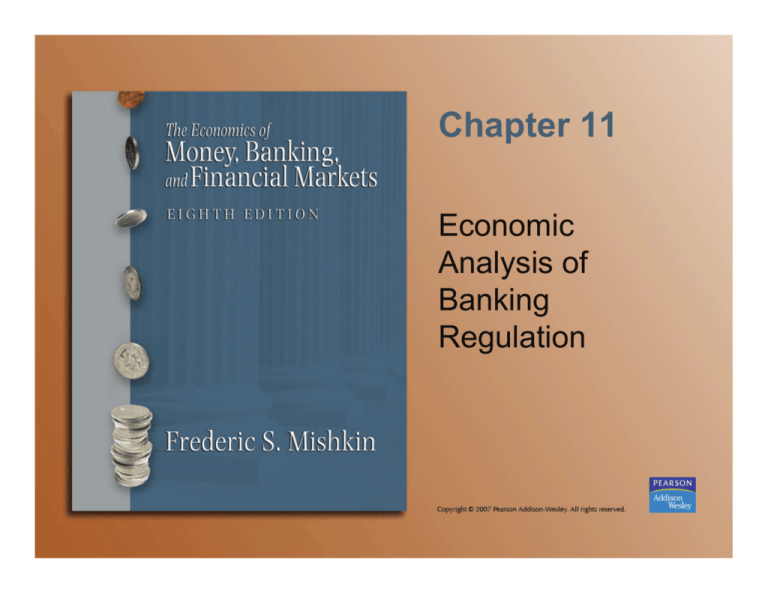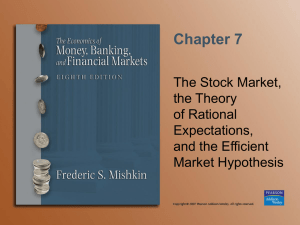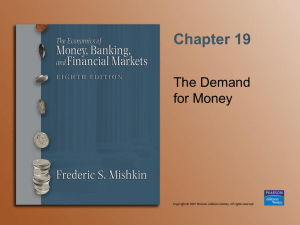
Chapter 11
Economic
Analysis of
Banking
Regulation
Asymmetric Information
and Bank Regulation
• Government safety net: Deposit insurance and
the FDIC
Short circuits bank failures and contagion effect
Payoff method
Purchase and assumption method
• Moral Hazard
Depositors do not impose discipline of marketplace
Banks have an incentive to take on greater risk
• Adverse Selection
Risk-lovers find banking attractive
Depositors have little reason to monitor bank
Copyright © 2007 Pearson Addison-Wesley. All rights reserved.
11-2
Too Big to Fail
• Government provides guarantees of
repayment to large uninsured creditors
of the largest banks even when they are
not entitled to this guarantee
• Uses the purchase and assumption
method
• Increases moral hazard incentives for
big banks
Copyright © 2007 Pearson Addison-Wesley. All rights reserved.
11-3
Financial Consolidation
• Larger and more complex banking
organizations challenge regulation
Increased “too big to fail” problem
Extends safety net to new activities,
increasing incentives for risk taking in
these areas
Copyright © 2007 Pearson Addison-Wesley. All rights reserved.
11-4
Restrictions on Asset Holding
and Bank Capital Requirements
• Attempts to restrict banks from too much
risk taking
Promote diversification
Prohibit holdings of common stock
Set capital requirements
• Minimum leverage ratio
• Basel Accord: risk-based capital requirements
• Regulatory arbitrage
Copyright © 2007 Pearson Addison-Wesley. All rights reserved.
11-5
Bank (Prudential) Supervision:
Chartering and Examination
• Chartering (screening of proposals to open new
banks) to prevent adverse selection
• Examinations (scheduled and unscheduled) to monitor
capital requirements and restrictions on asset holding
to prevent moral hazard
Capital adequacy
Asset quality
Management
Earnings
Liquidity
Sensitivity to market risk
• Filing periodic ‘call reports’
Copyright © 2007 Pearson Addison-Wesley. All rights reserved.
11-6
Assessment of Risk Management
• Greater emphasis on evaluating soundness of
management processes for controlling risk
• Trading Activities Manual of 1994 for risk management
rating based on
Quality of oversight provided
Adequacy of policies and limits
Quality of the risk measurement and monitoring systems
Adequacy of internal controls
• Interest-rate risk limits
Internal policies and procedures
Internal management and monitoring
Implementation of stress testing and Value-at risk (VAR)
Copyright © 2007 Pearson Addison-Wesley. All rights reserved.
11-7
Disclosure Requirements
• Requirements to adhere to standard
accounting principles and to disclose
wide range of information
• Eurocurrency Standing Committee of the
G-10 Central Banks also recommends
estimates of financial risk generated by
the firm’s internal monitoring system be
adapted for public disclosure
Copyright © 2007 Pearson Addison-Wesley. All rights reserved.
11-8
Consumer Protection
• Truth-in-lending mandated under the
Consumer Protection Act of 1969
• Fair Credit Billing Act of 1974
• Equal Credit Opportunity Act of 1974,
extended in 1976
• Community Reinvestment Act
Copyright © 2007 Pearson Addison-Wesley. All rights reserved.
11-9
Restrictions on Competition
• Justified by moral hazard incentives to
take on more risk as competition
decreases profitability
Branching restrictions (eliminated in 1994)
Glass-Steagall Act (repeated in 1999)
• Disadvantages
Higher consumer charges
Decreased efficiency
Copyright © 2007 Pearson Addison-Wesley. All rights reserved.
11-10
Copyright © 2007 Pearson Addison-Wesley. All rights reserved.
11-11
Copyright © 2007 Pearson Addison-Wesley. All rights reserved.
11-12
Copyright © 2007 Pearson Addison-Wesley. All rights reserved.
11-13
International Banking Regulation
• Similar to U.S.
Chartered and supervised
Deposit insurance
Capital requirement
• Particular problems
Easy to shift operations from one country
to another
Unclear jurisdiction lines
Copyright © 2007 Pearson Addison-Wesley. All rights reserved.
11-14
Regulation
• Applies to a moving target
Calls for resources and expertise
• Details are important
• Political pressures
Copyright © 2007 Pearson Addison-Wesley. All rights reserved.
11-15
Copyright © 2007 Pearson Addison-Wesley. All rights reserved.
11-16
1980s S&L and Banking Crisis
• Financial innovation and new financial
instruments increasing risk taking
• Increased deposit insurance led to
increased moral hazard
• Deregulation
Depository Institutions Deregulation and
Monetary Control Act of 1980
Depository Institutions Act of 1982
Copyright © 2007 Pearson Addison-Wesley. All rights reserved.
11-17
1980s S&L
and Banking Crisis (cont’d)
• Managers did not have expertise in
managing risk
• Rapid growth in new lending, real estate
in particular
• Activities expanded in scope; regulators at
FSLIC did not have expertise or resources
• High interest rates and recession increased
incentives for moral hazard
Copyright © 2007 Pearson Addison-Wesley. All rights reserved.
11-18
1980s S&L and Banking Crisis:
Later Stages
• Regulatory forbearance by FSLIC
Insufficient funds to close insolvent S&Ls
Established to encourage growth
Did not want to admit agency was in trouble
• Zombie S&Ls taking on high risk projects and
attracting business from healthy S&Ls
• Competitive Equality in Banking Act of 1987
Inadequate funding
Continued forbearance
Copyright © 2007 Pearson Addison-Wesley. All rights reserved.
11-19
Principal-Agent Problem
for Regulators and Politicians
• Agents for voters-taxpayers
• Regulators
Wish to escape blame (bureaucratic gambling)
Want to protect careers
Passage of legislation to deregulate
Shortage of funds and staff
• Politicians
Lobbied by S&L interests
Necessity of campaign contributions for expensive
political races
Copyright © 2007 Pearson Addison-Wesley. All rights reserved.
11-20
The Financial Institutions Reform,
Recovery, and Enforcement Act of 1989
• Regulatory apparatus restructured
Federal Home Loan Bank Board relegated
to the OTS
FSLIC given to the FDIC
RTC established to manage and resolve
insolvent thrifts
• Cost of the bailout approximately $150 billion
• Re-restricted asset choices
Copyright © 2007 Pearson Addison-Wesley. All rights reserved.
11-21
The Financial Institutions Reform, Recovery,
and Enforcement Act of 1989 (cont’d)
• Increased core-capital leverage requirements
• Imposed same risk-based capital standards as
those on commercial banks
• Enhanced enforcement powers of regulators
• Did not focus on underlying moral hazard and
adverse selection problems
Copyright © 2007 Pearson Addison-Wesley. All rights reserved.
11-22
Federal Deposit Insurance
Corporation Improvement Act of 1991
• Recapitalize the Bank Insurance Fund
Increase ability to borrow from the Treasury
Higher deposit insurance premiums until the loans
could be paid back and reserves of 1.25% of
insured deposits maintained
• Reform the deposit insurance and regulatory
system to minimize taxpayer losses
Too-big-to-fail policy substantially limited
Prompt corrective action provisions
Risk-based insurance premiums
Copyright © 2007 Pearson Addison-Wesley. All rights reserved.
11-23
Copyright © 2007 Pearson Addison-Wesley. All rights reserved.
11-24
Copyright © 2007 Pearson Addison-Wesley. All rights reserved.
11-25
Copyright © 2007 Pearson Addison-Wesley. All rights reserved.
11-26
Copyright © 2007 Pearson Addison-Wesley. All rights reserved.
11-27
Deja Vu
• It is the existence of a government
safety net that increases moral hazard
incentives for excessive risk taking on
the part of banks
Copyright © 2007 Pearson Addison-Wesley. All rights reserved.
11-28








